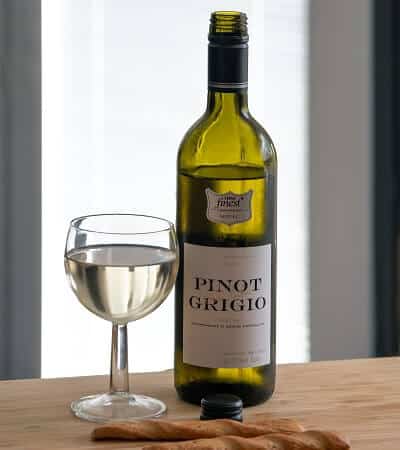Pinot Grigio is a varietal that produces blue-grayish grapes. Winemakers use them to make white wines that are light, fresh, and crisp with intense citrus aromas. Depending on the region where they cultivate the grapes, they can range from very dry to sweet.
Finding great wines can be challenging because many vintners bulk-produce wines of relatively low quality. Also, the variety is known by many other names around the world. In this article, we will discuss not only all the names of the grape, and where the best wines made from it come from.
PINOT GRIGIO VS. PINOT GRIS – WHAT IS THE DIFFERENCE?
There is no difference between Pinot Gris and Pinot Grigio. “Grigio” is the Italian word for “grey”, while “gris” is the French translation. So the two are localized names for the same varietal. In this article, we will use them synonymously.
THE PINOT GRIGIO VARIETAL
Pinot Grigio grapes are believed to be a mutation of the red Pinot Noir varietal. That might be the reason for the rather strange color of the grapes. Unlike other varietals for white wine, they are rather dark. They can vary from blue-gray to pink-red, and it is not unusual to find clusters with grapes of multiple different colors.
The grapes are thin-skinned and prone to mildew, chlorosis, and other diseases. Sudden temperature changes can harm them, too. To provide optimal conditions, they typically are grown on south-facing vineyards. That is, in particular, important in colder Old World countries.
As the grapes mature and ripen early in the year, they contain high levels of sugar when harvested. If vintners want them to also contain plenty of acidity, they gather them soon after ripening.
WHERE DOES PINOT GRIGIO COME FROM?
The varietal originates from the French Burgundy region, where it is known as “Pinot Gris”. From there, it made its way into Switzerland and Italy in the 13th and 14th centuries. Italian winemakers gave it the name “Pinot Grigio”.
Over the centuries, the varietal spread around Europe, including Austria, Germany, Hungary, and Slovenia. And in the 1960s, it also came to Oregon, and, a couple of years later, to California. Nowadays, you can find plantings in Australia, New Zealand, South Africa, and several countries in South America.
The grape (and the wines made from it) can have different names depending on the region. The following list shows you the most common synonyms:
- France: Pinot Gris, Auxerrois Gris, Fauvet, Fromentau/Fromentot, Gris Cordelier, Malvoisie
- Germany, Austria: Ruländer, Grauburgunder/Grauer Burgunder, Grauklevner/Grauer Klevner, Grauer Mönch
- Italy: Pinot Grigio
- Czech Republic, Slovakia: Rulandské šedé
- Croatia, Slovenia: Sivi Pinot
- Hungary: Szurkebarat
- Greece: Monemvasia
HOW DOES PINOT GRIGIO WINE TASTE?
Depending on the wine region, Pinot Gris can range from bone dry to very sweet.
The sweet and semi-sweet wines have a medium to full body and an oily texture. They offer fruity aromas such as citrus, cantaloupe, or peach.
Dryer wines typically showcase crisp acidity. They can be fruity with similar notes as sweet wines. Or they can showcase mineral and herbal tastes. In any case, the dry variations are significantly lighter with lower alcohol content than the sweet styles.
Which Pinot Grigio Wines Are Dry?
Italian Pinot Grigio wines from the Friuli-Venezia Giulia region typically are on the dry side of the spectrum. Vintners harvest the vines early in the year when the grapes contain a high level of acidity. The high-quality wines they make from these grapes are light, crisp, and well-balanced, with a wide variety of aromas. When enjoying them, you can perceive notes of green apple, pear, melon, and apricot, but also mineral or floral flavors.
Trentino-Alto Adige is another Italian wine region popular for high-quality Pinot Grigio. The area that borders Switzerland and Austria is home to eight DOC regions. About 75% of all wines from Trentino-Alto Adige carry this quality label. The wines are dry too, but more similar to German wines (see below) than those from Friuli-Venezia Giulia.
Many other Italian regions produce dry styles, too. But they’re often bulk-produced and thus lack the quality of the formerly mentioned wines.
German Grauburgunder wines from the Pfalz region (English: Palatinate region) also belong to the dry category. Along the Rhine river, vintners find optimal conditions to grow grapes. They produce light, approachable wines with bright, fruity, and mineral flavors.
Most Pinot Gris wines from Central and Eastern Europe are dry as well. That is true particularly for wines from the foothills of the alps in Switzerland, Austria, or Slovenia, but also for wines from Hungary, Croatia, and the Czech Republic.
Which Pinot Grigio Wines Are Sweet?
Sweet Pinot Grigio wines are rare. Nevertheless, you can find examples from different regions.
The most noteworthy type comes from the French Alsace AOC region. Vintners let the grapes for these wines ripen very long, so they accumulate a lot of sugar. Processing these sugar-rich grapes results in semi-sweet golden wines. They combine a medium to full body with complex floral bouquets that feature notes of citrus, honey, and spices. Typically, Alsace Pinot Gris is as age-worthy as a complex red wine.

City of Kaysersberg in the Alsace Region, France
Pinot Gris from New World wine countries such as Australia, New Zealand, or Chile can be semi-sweet, but it is rare to find them. And the same goes for off-dry styles from Washington State and Oregon. All of these wines are less sweet than Alsace wines, but they are significantly sweeter than the dry European styles.
HOW TO SERVE PINOT GRIS
Pinot Grigio wines should be served chilled. A temperature between 45 and 50°F (7-10°C) is fine. Aim for the lower end of this range for dry styles. For sweet wines, pick the upper end.
The right glass has a narrow, round bowl that allows a bit of airflow but not too much. The rim’s shape is important to direct the wine to the tip and the sides of your tongue to balance out its sweetness and acidity.
If you do not have this special glass, go for a Chardonnay glass or a standard white wine glass.
PINOT GRIGIO FOOD PAIRING
Dry Pinot Grigio wines are very versatile in terms of food pairing. Here are some ideas:
- As they are light and refreshing, they pair well with light seafood such as shrimp, oysters, or scallops. Especially in combination with fresh fish and a bit of lemon juice, the wine can showcase its crisp acidity and citrus flavors.
- White meat like chicken is a great match, too, given the meal is not too heavy. Light white sauces or herbal marinades are fine, but savory preparations like Chicken Marsala or Coq au Vin would be too heavy.
- A fresh salad with vinegar and oil is a delicious match, too. Of course, you can add fish or chicken to it.
- The same goes for pasta. Variations with vegetables, salmon or poultry, and light sauces are great matches.
- Soft cheeses with mild aromas and low-fat content are another food that goes well with dry styles. Mozzarella or Provolone belong in this category.
- Finally, try it with Italian antipasti like marinated olives, preserved bell peppers, and sun-dried tomatoes. Add some cured meats such as Prosciutto or Salami, and you have a fantastic starter course for your Italian dinner night.
Fuller-bodied variations are a little bit harder to pair with food. Nevertheless, you can create delicious combinations:
- Meaty fish with heavier, creamy sauces is great with full-bodied wines.
- The same is true for savory pork or lamb dishes.
- You can also match it with Italian desserts, given they aren’t too sweet. Think of red or black fruits with Panna Cotta, Zabaglione, or Mascarpone.
PINOT GRIGIO SHOPPING TIPS
When shopping, make sure you get the right style. Once again, most European styles are dry, except for Alsace AOC wines. Also, labels such as “Vendage Tardive” (English: late harvest) are a clear indicator of sweet wine. Check out these bottles:
Domaines Schlumberger Spiegel Grand Cru 2018
- type: white, still, sweet, Vintage
- origin: France, Alsace
- varietal: Pinot Gris
- alcohol: 13.5%
Albert Boxler Sommerberg Wibtal 2016
- type: white, still, off-dry, Vintage
- origin: France, Alsace
- varietal: Pinot Gris
- alcohol: 14.0%
- type: white, still, off-dry, Vintage
- origin: France, Alsace
- varietal: Pinot Gris
- alcohol: 13.5%

Pinot Grigio from Trentino-Alto Adige
Italian wines are among the best dry wines – if you buy the right ones. Stick to the wines from Friuli-Venezia Giulia and Trentino-Alto Adige to get a high-quality beverage. Here are some recommendations:
Santa Margherita Pinot Grigio 2020
- type: white, still, dry, Vintage
- origin: Italy, Trentino-Alto Adige
- varietal: Pinot Gris
- alcohol: 12.5%
Tiefenbrunner Pinot Grigio 2019
- type: white, still, dry, Vintage
- origin: Italy, Trentino-Alto Adige
- varietal: Pinot Gris
- alcohol: 12.5%
- type: white, still, dry, Vintage
- origin: Italy, Friuli-Venezia Giulia
- varietal: Pinot Gris
- alcohol: 13.0%
FINAL WORDS
Pinot Grigio is an extraordinary varietal, not only because of the grape color but also because of its versatility. With the deliciously sweet and fresh dry wines it produces, it has something to offer for every wine lover. Try for yourself which style you like best.






